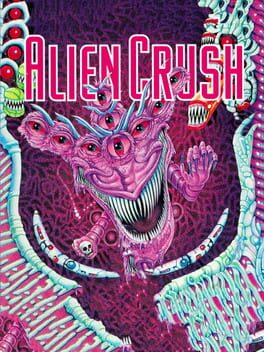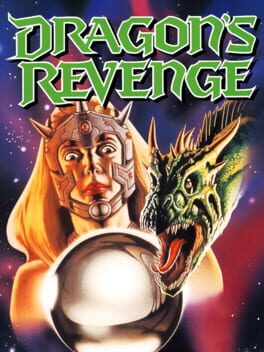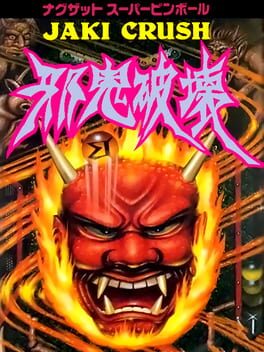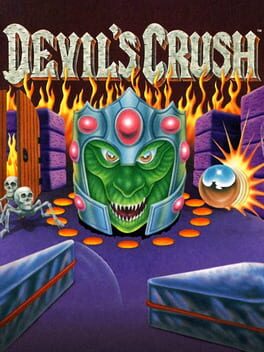

Fight against the aliens with your pinball skills! Imagine a living pinball machine...with aliens and outlandish worlds to throw at you. And turbo-charged, speed-of-light pinball action. You control the flippers and ball speed to defeat the Slime, the Tentacloid and Scorpion. Go for the eyes! This is full-tilt, out-of-this-world action! Surrealistic graphics plus true-to-life, earsplitting arcade pinball sound. Achieve the maximum possible score of 10 less than 1 billion and the game ends with the destruction of the table and a congratulatory message. The game is the first installment in the Crush Pinball series. It was followed by three sequels, Devil's Crush, Jaki Crush, and Alien Crush Returns.
Also in series
Released on
Genres
Reviews View More
Name's right, I love me so googly-eyed Giger bois. Video pinball should try to be this homoerotic more often. I mean, we're whacking balls around in a dungeon, what more can I ask for?! The Crush Pinball series has this almost sexual energy to it, an addictive game loop I find hard to resist. You quickly understand all that's possible, desirable, and repeatable with just one main table and a few mini-tables to spice things up. It's the familiar rhythm of the plunger, flippers, bumpers, and multipliers throwing the odds across screens, from 0 digits to 999 million, threatening us with imminent loss but also the possibility of success. And I think there's something delightfully sleazy about the thrill of it all. Forget the joysticks, the video nasties, the banes of "concerned parents" and the policymakers who answer to them with curfews and dress codes. We want the real thing!
Whether you're just giving it a 15-minute try or aiming to counter-stop, Alien Crush remains as fun and relevant to the genre as it must have been in 1988. This was the best pinball romp of the '80s, stacking up to ye olde Black Knight 2000 and Pin-Bot in presentation and execution. The counter-cultural, tongue-in-cheek pairing of eldritch horrors with a well-balanced table design allowed developers Compile and Red Company to take risks other microchip adaptations hadn't. Unlockable "boss" stages and multiple ways to nab new balls, or toggle safety zones amidst the chaos, makes for a very fair experience overall. Most importantly, though, the pinball physics here are impeccable. Rarely does it feel like sloppy coding's the source of a failed run, and there's almost always some way to recover by smartly timing flips and tilts to control your trajectory. This may not have the sheer amount of stuff that Devil's Crush and its progeny brought, but this inaugural entry in the "not quite pinball" style has held its own against those successors.
| Lunar Eclipse |
Whoever at Compile led development on this, Devil's Crush, and an ever-overlooked Jaki Crush clearly loved post-WWII pinball and similar amusements. (Interviews with ex-Compile staff suggest that Takafumi Tanida was the Crush Pinball games' lead developer, supported by his work on The Pinball of the Dead a decade later) (Szczepaniak 2018, 112). Arcades, dive bars, movie theaters, and other third spaces benefited from the blaring clangs and klaxons these four-legged monstrosities put out. Before our age of eye-straining, dexterity testing shooters and eSports curricula, skill-based bagatelle was the next best way to hone one's reflexes and proudly scream to the world "I'm a creature of leisure!" with enough carpe diem to make Robin Williams blush. It's fitting that pinball video carts and disks would struggle to replicate, let alone enhance, the electromechanical stimuli and complexity of contemporary tables from Bally, Williams, Stern, Gottlieb, and other manufacturers in and outside of Chicago. Few console or micro-computer examples of the genre had much success until the late-'80s, when the likes of Pinball Quest and then DICE's Pinball Dreams showed how upgraded ROM chips and clever design could allow richer, more complex tables and player progression than even the priciest cabinet competitors.
Ironically, though pinball has always had more presence in the U.S. and other parts of the Global West, it's mainly Japanese video game creators who pushed the limits of this style of arcade staple for home audiences. I'm not downplaying the revolution that was Pinball Construction Set, either. Bill Budge's proto-amateur game dev toolkit offered many options to players, from building layouts to tweaking gravity, but it strictly adhered to the possibility space of mid-1900s pinball. Replicating the flashy LED banners, sampled audio, and exuberant light shows popular in '80s arcade-adjacent spaces wasn't going to work on an Apple II, not without compromises. Even virtuosic pseudo-replica tables in releases like System Sacom's Moon Ball still fell prey to wonky physics or a lack of variety. It's telling that the earliest signs of video games advancing pinball tropes came via genre hybrids like Toru Iwatani's Bomb Bee, combining Breakout into the formula to some success. Realistic pinball recreations, on the other hand, wouldn't arrive in force until the '90s, when works like Little Wing's Tristan from '91 became popular on various PCs (Fujita 2010).
Though Sacom and their star coder Mark Flint brought Moon Ball Magic to the Famicom Disk System, expanding the original into a multi-level adventure with some deft, it was a nascent Naxat Soft who'd publish the first majorly acclaimed contender to the video-ball throne that same year. The newborn publisher contracted Red Entertainment, then working on other big PC Engine projects like Far East of Eden, to design and produce an action-packed crowd pleaser alongside technical staff from the ever-reliable Compile. Even if Red was still just as inexperienced with making their own games as Naxat was to publishing, they clearly made a lot of smart decisions. Tanida and co. needed roughly a half-year to craft and gold-master Alien Crush, which gained a global cult following unlike Sacom's product. It may not have been a launch title in Japan (though close enough in concept and legacy), but the Turbo-Grafx 16 localization was a boon for the platform, already struggling against the NES despite its advantages.
| Demon's Undulate |
Alien Crush boots into a minimalist, fleshy-formed splash screen with ominous HuC6280 waveforms purring in stereo. Tap Run, choose Fast or Slow, and then choose one of two music tracks to regale you as the ballistics begin. The opening pull-and-plunge does a proper job of introducing players to an otherwise troublesome quirk, its fade-to-black flipping between halves of the table. Split-second blanks take a bit of getting used to if you've only experienced newer full-scrolling pinball games; any fading here feels unobtrusive after a minute or two, thankfully. Despite the busy visuals, it's easy to keep track of the silver ball leaping from corner to corner, top to bottom, at least on the main table where one can actually lose it. Two sets of flippers, multiple point indicators baked into a grotesque root system, portentous open aisles leading to either the motherlode or the next ball down…it's plenty to take in, but never too much.
The core loop takes our metallic traveler around a circuit of enough cybernetic guts and gnasties to make Ridley Scott proud. In the center-bottom rests the phallic-formed demiurge, with its retinue of x-number panels and fallen angels in the gallery for you to strike down. Contrast this with dual brains and their head henchmen on top, vying for control and kept at tendrils' length by the standard four pass-thru switches. It's the very model of a modern major pinball table, corrupted and reshaped into a torture device for completionists. "Beating" this nets only the most barebones of endings and bragging rights expected from a big-budget machine, the kind you'd just walk away from to find something else worth playing. Playing this with today's content-first mindset is a trap. While there are innovators like Flipnic: Ultimate Pinball and Yoku's Island Express which effectively meld scoring and completionism paradigms, Alien Crush works as much as it can from its limited but compelling set-up. Some would call this a "vibe game", in fact, which is close enough to describing the thick atmosphere roping me back into this hellscape.
Activating each nib, greeble, ramp, and gargoyle nets you some numbers, but also access to a few interesting "secret areas" which break up the pacing in ways a non-console table can't. I wish Tanida and the rest had gone even farther with this idea, which is why I suspect I'll enjoy the sequels more for doubling down on them. These diversions all use the block kuzushi style of ball-and-paddle play that Breakout had popularized in Japan a decade earlier, just using proper pinball physics. It's crunchy and satisfying to bounce skulls back into their hidey holes, or figure out how to juggle between sets of bumpers without the ball jumping down right between the flippers. Unlike the main table and its perpetual endurance tests, players can actually complete these side areas for a perfect score bonus, plus a hidden extra ball in one of the rooms. It'd take Devil's Crush and beyond to really iterate on this concept, but everything works here despite the repetitive, somewhat underwhelming amount of unique bosses and baddies to bop.
| The Best Five |
Most of the PC Engine and TurboGrafx-16's initial lineup suffered from stinkers and well-meaning but flawed software. I can't think of many out there clamoring to play Victory Run or Keith Courage in Alpha Zones nowadays, except myself maybe. Hudson Soft and NEC did their damnedest to make this platform work, though, and their third-party talent scouting paid off with classics like Alien Crush, Blazing Lazers, Cyber Knight, and CD-ROM extravaganzas like, uh, J.B. Harold Murder Club. OK, not all of these are so prestigious, and rarely did the most well-received games venture out of genre norms. (Hudson's own catalog did well enough to avoid obvious blunders, even if they also weren't rocking the proverbial boat with Bonk's Adventure or Nectaris.) Still, if you had to get any of the original four TG-16 HuCards back in '89, this once cutting-edge take on pinball was the smart choice. What better means to showcase the advanced spriting, scrolling, and thematic exploring one could create on this new hardware?
For reasons both selfish and convenient, I wanted to start my PC Engine journey off with a Certified Hood Classic™. All the Crush Pinball titles would have worked, so starting with the original made too much sense. But imagine how difficult a sell this would have seemed in '88 or '89. Who needs video pinball when high quality tables are available at every laundromat, community center, etc.? The highest achievement this series reached was justifying its genre's relevance beyond the realms of coin-boxes and carnival barkers, largely by hooking players with what the big pinball companies refused to provide. I love me some blockbuster '80s cabs from Williams, followed by the lofty heights Stern reached heading into the '90s, but they couldn't sweep the main-table ideal off its feet like Alien Crush did. This underdog of a printed circuit soon had its own imitators, like the oft-maligned Sonic Spinball and similar mascot pinball-ers. It showed to a developing enthusiast press that even the most seemingly impossible of genre hybrids weren't just possible, but laudable! Just as the PC Engine/TG-16 had to prove itself against Nintendo and SEGA's status quo from start to bitter end, so too have creations like this needed to justify their relevance from one era to another. I think everyone working on this at Compile, Red Company, and Naxat Soft outdid themselves.
—Bibliography—
Fujita, Yoshikatsu. “Tristan.” LittleWing PINBALL Official Website. LittleWing Co. Ltd., November 2, 2010. https://web.archive.org/web/20101102014644/http://www.littlewingpinball.com/doc/en/gameinfo/tristan/index.html.
Accessed via Internet Archive.
Szczepaniak, John. “Takayuki HIRONO & Satoshi FUJISHIMA.” The Untold History of Japanese Game Developers Vol. 3, 112–113. SMG Szczepaniak, 2018.
Whether you're just giving it a 15-minute try or aiming to counter-stop, Alien Crush remains as fun and relevant to the genre as it must have been in 1988. This was the best pinball romp of the '80s, stacking up to ye olde Black Knight 2000 and Pin-Bot in presentation and execution. The counter-cultural, tongue-in-cheek pairing of eldritch horrors with a well-balanced table design allowed developers Compile and Red Company to take risks other microchip adaptations hadn't. Unlockable "boss" stages and multiple ways to nab new balls, or toggle safety zones amidst the chaos, makes for a very fair experience overall. Most importantly, though, the pinball physics here are impeccable. Rarely does it feel like sloppy coding's the source of a failed run, and there's almost always some way to recover by smartly timing flips and tilts to control your trajectory. This may not have the sheer amount of stuff that Devil's Crush and its progeny brought, but this inaugural entry in the "not quite pinball" style has held its own against those successors.
| Lunar Eclipse |
Whoever at Compile led development on this, Devil's Crush, and an ever-overlooked Jaki Crush clearly loved post-WWII pinball and similar amusements. (Interviews with ex-Compile staff suggest that Takafumi Tanida was the Crush Pinball games' lead developer, supported by his work on The Pinball of the Dead a decade later) (Szczepaniak 2018, 112). Arcades, dive bars, movie theaters, and other third spaces benefited from the blaring clangs and klaxons these four-legged monstrosities put out. Before our age of eye-straining, dexterity testing shooters and eSports curricula, skill-based bagatelle was the next best way to hone one's reflexes and proudly scream to the world "I'm a creature of leisure!" with enough carpe diem to make Robin Williams blush. It's fitting that pinball video carts and disks would struggle to replicate, let alone enhance, the electromechanical stimuli and complexity of contemporary tables from Bally, Williams, Stern, Gottlieb, and other manufacturers in and outside of Chicago. Few console or micro-computer examples of the genre had much success until the late-'80s, when the likes of Pinball Quest and then DICE's Pinball Dreams showed how upgraded ROM chips and clever design could allow richer, more complex tables and player progression than even the priciest cabinet competitors.
Ironically, though pinball has always had more presence in the U.S. and other parts of the Global West, it's mainly Japanese video game creators who pushed the limits of this style of arcade staple for home audiences. I'm not downplaying the revolution that was Pinball Construction Set, either. Bill Budge's proto-amateur game dev toolkit offered many options to players, from building layouts to tweaking gravity, but it strictly adhered to the possibility space of mid-1900s pinball. Replicating the flashy LED banners, sampled audio, and exuberant light shows popular in '80s arcade-adjacent spaces wasn't going to work on an Apple II, not without compromises. Even virtuosic pseudo-replica tables in releases like System Sacom's Moon Ball still fell prey to wonky physics or a lack of variety. It's telling that the earliest signs of video games advancing pinball tropes came via genre hybrids like Toru Iwatani's Bomb Bee, combining Breakout into the formula to some success. Realistic pinball recreations, on the other hand, wouldn't arrive in force until the '90s, when works like Little Wing's Tristan from '91 became popular on various PCs (Fujita 2010).
Though Sacom and their star coder Mark Flint brought Moon Ball Magic to the Famicom Disk System, expanding the original into a multi-level adventure with some deft, it was a nascent Naxat Soft who'd publish the first majorly acclaimed contender to the video-ball throne that same year. The newborn publisher contracted Red Entertainment, then working on other big PC Engine projects like Far East of Eden, to design and produce an action-packed crowd pleaser alongside technical staff from the ever-reliable Compile. Even if Red was still just as inexperienced with making their own games as Naxat was to publishing, they clearly made a lot of smart decisions. Tanida and co. needed roughly a half-year to craft and gold-master Alien Crush, which gained a global cult following unlike Sacom's product. It may not have been a launch title in Japan (though close enough in concept and legacy), but the Turbo-Grafx 16 localization was a boon for the platform, already struggling against the NES despite its advantages.
| Demon's Undulate |
Alien Crush boots into a minimalist, fleshy-formed splash screen with ominous HuC6280 waveforms purring in stereo. Tap Run, choose Fast or Slow, and then choose one of two music tracks to regale you as the ballistics begin. The opening pull-and-plunge does a proper job of introducing players to an otherwise troublesome quirk, its fade-to-black flipping between halves of the table. Split-second blanks take a bit of getting used to if you've only experienced newer full-scrolling pinball games; any fading here feels unobtrusive after a minute or two, thankfully. Despite the busy visuals, it's easy to keep track of the silver ball leaping from corner to corner, top to bottom, at least on the main table where one can actually lose it. Two sets of flippers, multiple point indicators baked into a grotesque root system, portentous open aisles leading to either the motherlode or the next ball down…it's plenty to take in, but never too much.
The core loop takes our metallic traveler around a circuit of enough cybernetic guts and gnasties to make Ridley Scott proud. In the center-bottom rests the phallic-formed demiurge, with its retinue of x-number panels and fallen angels in the gallery for you to strike down. Contrast this with dual brains and their head henchmen on top, vying for control and kept at tendrils' length by the standard four pass-thru switches. It's the very model of a modern major pinball table, corrupted and reshaped into a torture device for completionists. "Beating" this nets only the most barebones of endings and bragging rights expected from a big-budget machine, the kind you'd just walk away from to find something else worth playing. Playing this with today's content-first mindset is a trap. While there are innovators like Flipnic: Ultimate Pinball and Yoku's Island Express which effectively meld scoring and completionism paradigms, Alien Crush works as much as it can from its limited but compelling set-up. Some would call this a "vibe game", in fact, which is close enough to describing the thick atmosphere roping me back into this hellscape.
Activating each nib, greeble, ramp, and gargoyle nets you some numbers, but also access to a few interesting "secret areas" which break up the pacing in ways a non-console table can't. I wish Tanida and the rest had gone even farther with this idea, which is why I suspect I'll enjoy the sequels more for doubling down on them. These diversions all use the block kuzushi style of ball-and-paddle play that Breakout had popularized in Japan a decade earlier, just using proper pinball physics. It's crunchy and satisfying to bounce skulls back into their hidey holes, or figure out how to juggle between sets of bumpers without the ball jumping down right between the flippers. Unlike the main table and its perpetual endurance tests, players can actually complete these side areas for a perfect score bonus, plus a hidden extra ball in one of the rooms. It'd take Devil's Crush and beyond to really iterate on this concept, but everything works here despite the repetitive, somewhat underwhelming amount of unique bosses and baddies to bop.
| The Best Five |
Most of the PC Engine and TurboGrafx-16's initial lineup suffered from stinkers and well-meaning but flawed software. I can't think of many out there clamoring to play Victory Run or Keith Courage in Alpha Zones nowadays, except myself maybe. Hudson Soft and NEC did their damnedest to make this platform work, though, and their third-party talent scouting paid off with classics like Alien Crush, Blazing Lazers, Cyber Knight, and CD-ROM extravaganzas like, uh, J.B. Harold Murder Club. OK, not all of these are so prestigious, and rarely did the most well-received games venture out of genre norms. (Hudson's own catalog did well enough to avoid obvious blunders, even if they also weren't rocking the proverbial boat with Bonk's Adventure or Nectaris.) Still, if you had to get any of the original four TG-16 HuCards back in '89, this once cutting-edge take on pinball was the smart choice. What better means to showcase the advanced spriting, scrolling, and thematic exploring one could create on this new hardware?
For reasons both selfish and convenient, I wanted to start my PC Engine journey off with a Certified Hood Classic™. All the Crush Pinball titles would have worked, so starting with the original made too much sense. But imagine how difficult a sell this would have seemed in '88 or '89. Who needs video pinball when high quality tables are available at every laundromat, community center, etc.? The highest achievement this series reached was justifying its genre's relevance beyond the realms of coin-boxes and carnival barkers, largely by hooking players with what the big pinball companies refused to provide. I love me some blockbuster '80s cabs from Williams, followed by the lofty heights Stern reached heading into the '90s, but they couldn't sweep the main-table ideal off its feet like Alien Crush did. This underdog of a printed circuit soon had its own imitators, like the oft-maligned Sonic Spinball and similar mascot pinball-ers. It showed to a developing enthusiast press that even the most seemingly impossible of genre hybrids weren't just possible, but laudable! Just as the PC Engine/TG-16 had to prove itself against Nintendo and SEGA's status quo from start to bitter end, so too have creations like this needed to justify their relevance from one era to another. I think everyone working on this at Compile, Red Company, and Naxat Soft outdid themselves.
—Bibliography—
Fujita, Yoshikatsu. “Tristan.” LittleWing PINBALL Official Website. LittleWing Co. Ltd., November 2, 2010. https://web.archive.org/web/20101102014644/http://www.littlewingpinball.com/doc/en/gameinfo/tristan/index.html.
Accessed via Internet Archive.
Szczepaniak, John. “Takayuki HIRONO & Satoshi FUJISHIMA.” The Untold History of Japanese Game Developers Vol. 3, 112–113. SMG Szczepaniak, 2018.
Once again bored out of my mind, I start digging through my PC Engine's game collection. Find this neat little pinball game, and goddamn, the visceral experience of shredding aliens while furiously mashing the flippers was incredibly gratifying. If I need to blow off some steam, I'll come back to this hidden gem.




